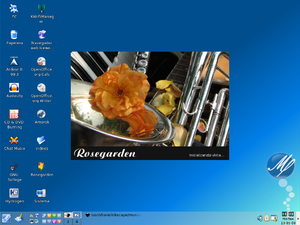Musix GNU+Linux
 | |
 Musix 1.0 R4 DVD. | |
| OS family | Unix-like |
|---|---|
| Working state | Current |
| Initial release | December 9, 2008 |
| Latest release | 3.0.1 / March 13, 2014 |
| Platforms | IA-32 |
| Kernel type | Monolithic (Linux-libre) |
| Userland | GNU |
| Default user interface | IceWM (previously KDE) |
| License | Exclusively free licenses per GNU Free System Distribution Guidelines (GNU FSDG)[1] |
| Official website | musixdistro |
Musix GNU+Linux is a live CD and DVD Linux distribution for the IA-32 processor family based on Debian. It contains a collection of software for audio production, graphic design, video editing and general purpose applications. The initiator and co-director of the project is Marcos Germán Guglielmetti.
Musix GNU+Linux is one of the few GNU/Linux distributions recognized by the Free Software Foundation as being primarily available on sites distributing free software and excluding any non-free information for practical use.[2]
Musix is developed by a team from Argentina, Spain, Mexico and Brazil. The main language used in development discussion and documentation is Spanish; however, Musix has a community of users who speak Spanish, Portuguese, and English.
Software
Musix 1.0
The Musix 0.x and 1.0 Rx versions were released from 2005 to 2008, with Musix 1.0 R6 being the last stable release on DVD and Musix 1.0 R2R5 the last stable release on CD.
The Live-CD system has more than 1350 software packages and runs directly from the CD/DVD without the need to install anything on the PC. It can be installed on the PC relatively easily if desired in a few minutes, just like Knoppix or Kanotix. The Live-DVD 1.0 R3 test5 has 2279 software packages.
Some of the programs include: Rosegarden and Ardour, both for musicians; Inkscape for vectorial design; GIMP for manipulation of images; Cinelerra for video editing and Blender for 3D animation.
Its desktop is very light (only 18 MB of RAM with X.org), based on IceWM/ROX-Filer and it has a unique feature: multiple "pinboards" ordered by General Purpose apps, Help, Office, Root/Admin, MIDI, Internet, Graphics, and Audio. The pinboards are arrays of desktop backgrounds and icons.
A small version of the KDE desktop is installed by default too on the Live-CD version. The Live-DVD has a full KDE version, supporting several languages.
Musix 2.0
Musix 2.0 is being developed using the live-helper scripts from the Debian-Live project. The first Alpha version of Musix 2.0[3] was released on 2009-03-25 including two realtime-patched Linux-Libre kernels.
On 2009-05-17 the first Beta version of Musix 2.0 was released.[4]
The final Musix GNU+Linux 2.0 version on CD, DVD and USB has been launched in November 2009 by Daniel Vidal, Suso Comesaña, Carlos Sanchiavedraz, Joseangon and other Musix developers. This version has been presented at the "Palau Firal de Congressos de Tarragona, España" by Suso Comesaña.
A quite similar LINUX-version is developed by a Brazilian music teacher Gilberto André Borges and is named "Adriane" or "MusixBr". This version is not a fork and is derived from Knoppix 6.1 Adriane.
See also
- Comparison of Linux distributions
- dyne:bolic – another free distribution for multimedia enthusiasts
- GNU/Linux naming controversy
- List of Linux distributions based on Debian
